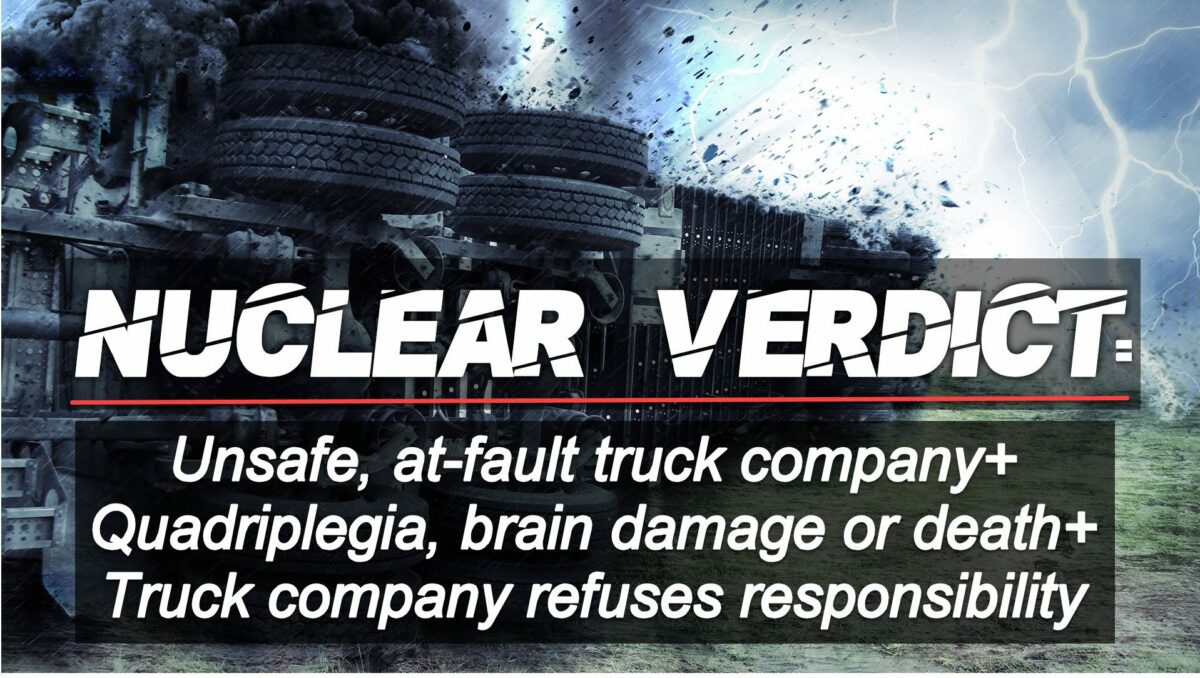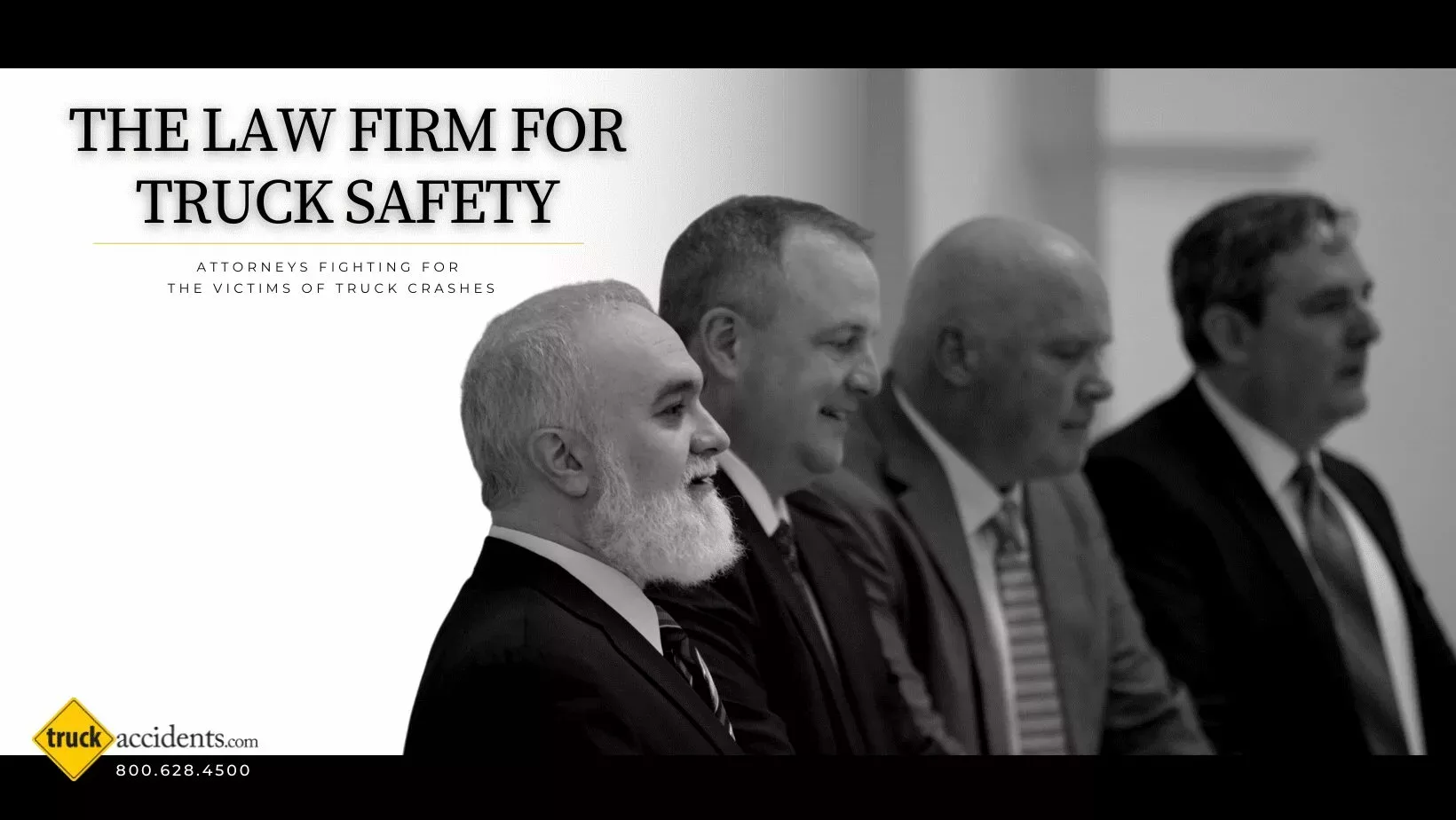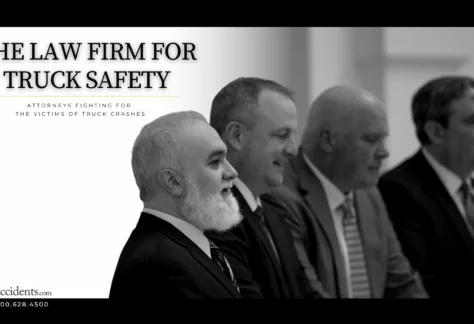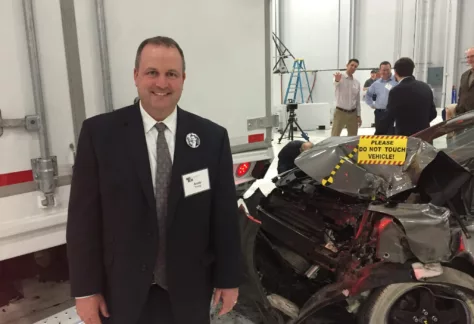
By: D. J. Young, III - June 24, 2020
Time after time, the trucking industry attempts to avoid responsibility for its misconduct. The most recent example is the report issued today by the American Transportation Research Institute (ATRI) entitled, Understanding the Impact of Nuclear Verdicts on the Trucking Industry.[1] This 82-page report contains a self-serving statistical analysis of 451 self-selected truck accident cases that resulted in jury verdicts, but it neglects important facts that cast ATRI’s conclusions into doubt. The report does not mention that fewer than 40 of its 451 cases actually meet ATRI’s own definition of “nuclear” verdict.[2] To ATRI’s credit, at least, it concludes that one way of avoiding nuclear verdicts is by safer trucking practices. But, because of the flaws in ATRI’s analysis, there is no basis for ATRI’s conclusion that legal reform is the solution.
ATRI Doesn't Tell the Story of Real People
Behind most of the large trucking verdicts is a family whose child or parent has been killed or in which a person has had limbs amputated, is brain damaged or is paralyzed. Actual costs typically exceed $10 million to pay medical bills, to fund the future cost of care in a facility or home and to replace the lost salary of the household wage earner. There can be no serious disagreement with verdicts that are $10 million or more in these cases. Otherwise, the at-fault trucking company ducks responsibility and many times taxpayers foot the bill through Medicaid, Medicare, Social Security Disability, and other government programs. This is a lose-lose. The injured person doesn't receive the level of care necessary; the taxpayers are forced to pay; and the at-fault partyA participant in a lawsuit. In a civil lawsuit, the party who sues is the plaintiff and the party being sued is the defendant. avoids accountability.
As just one example, one of our clients was 25 years old when he was rendered quadriplegic as a result of a tractor trailer crossing the center line of an interstate highway. His future cost of care will be approximately $18 million. If a jury rendered an $18 million verdict, should we call that a nuclear verdict? Maybe we should call it a nuclear injury that has destroyed a person's life. Or maybe we just call it truck companies taking responsibility when they maim or kill people.
ATRI’s Sole Interest is Trucking Industry Profits
In case there was any doubt about ATRI’s motives, a look at its board of directors is conclusive. Its board of directors is comprised of the following people, all of whom whose interests are aligned in the profitable operation of trucking companies: Judy McReynolds, CEO of ArcBest Corporation; Andrew Boyle, Co-President of Boyle Transportation; Hugh Ekberg, CEO of CRST International, Inc.; Darren D. Hawkins, CEO of YRC Worldwide; Dave Huneryager, CEO of Tennessee Trucking Association; Derek Leather, CEO of Werner Enterprises; Robert E. Low, President of Prime Inc.; Rich McArdle, President of UPS Freight; Benjamin McLean, CEO of Ruan Transportation Management Systems; Dennis Nash, Chairman of the Board of Kenan Advantage Group; James D. Reed, CEO of USA Truck; Annette Sandberg, CEO of Transsafe Consulting, LLC; John A. Smith, CEO of FedEx Freight; Rebecca Brewster, President of ATRI; and Chris Spear, CEO of American Trucking Associations. These people are the trucking industry. Not one ATRI board member represents the interests of ordinary people who share the roadways with trucks, not one ATRI board member represents the thousands of people who have been brain injured, rendered quadriplegics, or killed because of their industry’s negligence. Not one of ATRI’s board members even represents manufacturers of cars or trucks or vehicle safety equipment, car insurance companies, AAA, or AARP.
ATRI Relies on Statistical Outliers to Skew Data
Central to the ATRI Report is the alarmist claim that average truck accident jury verdicts are increasing 483%.[3] ATRI failed to include any citations to its claims about 451 truck verdicts, failed to cite any of the cases by name, and failed to explain the impact of outliers. ATRI concedes that data is more or less flat until 2018. According to my research,[4] in 2018 there were four so-called nuclear verdicts, two of which came from Upshur County, Texas, one of which was over $100 million and the other of which was over $260 million.[5] The normal average verdict is just over $3.1 million; it is not hard to see how these two anomalous Texas state court cases might have spiked ATRI’s average for 2018 to $22.2 million. Did ATRI account for the fact that one of those two cases settled for an undisclosed amount, and that the other was remitted (reduced by the court) to $33 million and that the outcome still remains uncertain because appeals are pending? Probably not, but we cannot know because ATRI’s report does not disclose any underlying data.
ATRI’s report says “Means were utilized in this analysis as opposed to other measures of central tendency as it is extremely important to include verdicts that fall outside of ‘typical.’”[6] Why is it extremely important to include those outside of typical? ATRI does not explain why. The “extreme importance” to ATRI clearly is to create the appearance of an enormous increase in 2018. But failing to disclose the existence and impact of removing those statistical outliers on the mean calculation is misleading. The reality is that, in terms of verdicts, 2018 was a normal year everywhere else in the United States other than Upshur County, Texas.
Nuclear Verdicts Do Not Correlate to Bankruptcies or Going Out of Business
The ATRI Report speculates that truck crash verdicts, especially the “nuclear verdicts,” somehow lead to motor carriers going out of business. The ATRI fails to offer anything other than anecdotal evidence of bankruptcies. ATRI could have conducted a basic search of the government’s pacer.gov website for any bankruptcy filings of the trucking companies involved in their ostensible list of 451 cases; it would have determined the number of trucking companies filing for bankruptcy and, of those, which filed for Chapter 7 (liquidation) and which filed for Chapter 11 (reorganization). If ATRI conducted any such research, it has withheld the results. Nor does explain that many corporations have historically used Bankruptcy Code Chapter 11 for strategic—and often lucrative—restructurings. The fact that a carrier filed for bankruptcy protection, then, does not automatically mean that the carrier is out of business. In fact, it may mean the very opposite.
My research indicates that of the approximately forty cases between 2011 and the present involving “nuclear verdicts,” only six of them appear to have closed their doors. Of these, most were not significant brand-name truck companies. In most cases, however, the truck company does not go out of business because the case is resolved within the insurance policy limits of the trucking company. It is reasonable to assume that the companies most likely to go out of business after a nuclear verdict are fly-by-night or reincarnated “chameleon carriers” that have literally re-titled and rebranded trucks to avoid a low or unsatisfactory safety score, penalties for safety violations, or even other verdicts; they obtained new USDOT numbers and resumed operations.
Nuclear Verdicts Generally Do Not Result in Nuclear Payouts
An unstated assumption in ATRI’s report is that all nuclear verdicts are paid. In fact, that is almost never the case. My research reveals that of the approximately forty truck cases with verdicts in excess of $10 million between 2011 and the present, almost every one of them involved some kind of private resolution after the jury reached the verdict. While most settlement agreements are confidential, one can easily determine if a case has settled by checking the court dockets in the cases. Sometimes the dockets disclose that the litigation was settled. Rarely do the dockets state the amounts of the settlements. But, cases do not just end for no reason whatsoever. When a docket shows an abrupt ending without rulings on pending issues, the parties likely settled the case privately. By checking various public sources including case dockets and SEC filings, I have determined that almost every one of the nuclear verdict cases settled, presumably for amounts within insurance coverage limits and much lower than the verdict amounts.
Post-verdict Litigation Was Not Considered by ATRI
My research reveals that post-verdict litigation is typical in nuclear verdict cases. The defendants almost always file post-trial motions seeking to challenge the verdict (for example, they file a motion for judgment notwithstanding the verdict or for new trials). The party that loses such motions almost always will file an appeal. In almost every such case, sometime during this post-verdict phase of the case, the case settles. In instances where there has not been a settlement, it is either because the injured party knows the defendantA defendant is the individual, company, or institution against whom a lawsuit is filed in a court of law. In the context of a legal dispute, the defendant is accused of causing harm or loss to the plaintiff, either through direct action, negligence, or failure to perform a duty. The defendant must respond to the plaintiff's complaint, offering defenses or counterarguments to the allegations made against them. In criminal cases, the defendant is the person charged with a crime, and the prosecution acts to prove the defendant's guilt beyond a reasonable doubt. truck company or its insurers (1) can pay the judgment and likely will be required to do so, or (2) has or likely will assign to the plaintiffA plaintiff is the person or party who initiates a lawsuit before a court. By filing a complaint, the plaintiff seeks legal remedy for the harm caused by the defendant's actions or inactions. In civil cases, the plaintiff is the party who claims to have incurred a loss due to the defendant's breach of duty or violation of their rights. In the United States, the plaintiff bears the burden of proving their case to obtain relief or damages from the defendant. a right to sue the insurance company based on the insurance company’s bad faith in the case (a “bad faith claim”).
Nothing in the ATRI report shows any attempt to quantify the impact of post-verdict litigation on the actual amounts paid. Only the actual amounts paid have the potential to impact the financial statements of the trucking company or the insurance company. Only the actual amount paid could have any impact on actuarial calculations of insurance risk. The fact that the ATRI report fails to consider the actual amounts paid versus the size of the verdict demonstrates that ATRI’s focus is misplaced and that ATRI’s conclusions are questionable at best.
ATRI Wrongly Concludes that Insurance Rate Increases Result from Truck Crash Verdicts
The ATRI report says that the nuclear verdicts tend to drive up insurance prices, but it cites zero empirical data to support this. Instead, ATRI surveyed its own constituents; that is, truck company insiders and insurance carriers who responded to questions about insurance rate increases.[7] But, nothing indicates that these questions were directed to the actuaries or underwriters at insurance companies. Allowing truck company insiders to answer questions about how insurance rates are determined is pure conjecture. And even the limited and potentially self-interested data derived from the survey respondents is not tallied and disclosed in the report.
And there is very good reason to believe that other factors are at work, unrelated to large crash verdicts, that are driving insurance rate increases. The Consumer Federation of America Center for Justice & Democracy Report, dated March of 2020, entitled, “How the Cash-Rich Insurance Industry Fakes Crises and Invents Social Inflation”[8] indicates that rate increases are tied to insurance industry practices that have little to nothing to do with actual claims. The factors that drive insurance rates are much, much more complicated and cannot be directly tied to nuclear verdicts that are likely reduced in any event during post-verdict litigation.
Instead, insurance rates are driven by multi-year considerations of the insurance company’s losses, reserves, surplus, investments, loss ratio, the recurring insurance cycle of hard markets and soft markets, and insurance regulation—which varies significantly from one state to another. According to the Center for Justice & Democracy Report, “this is an industry that has stored away so much excess profit that it now sits on more surplus than at any time in history – a record level of well over $800 billion.”[9] Typically, the insurance industry blames the legal system when it faces a purported economic crises, but blaming the legal system has proven generally unsuccessful and now the insurance industry is blaming a new concept that it invented, “social inflation,” as an excuse for raising rates[10] which is a backhanded way of blaming jurors.[11] The Center for Justice & Democracy’s research concludes that the while the insurance industry claims that it is suffering losses, it is “actually massively prospering” and that “insurers’ surplus – the money held above that reserved for expected losses – doubled from 2004 to 2018, quadrupled since 1994, and has risen by more than 5,000% over the past 60 years. It is now at all-time record levels.” [12] Raising claim reserves can be an excuse to raise insurance rates, “but also to lower tax liabilities at times of significant profits.”[13] Perhaps most tellingly, “Since 1999, total commercial insurance payouts have never spiked and have generally tracked the rate of inflation and population. Premiums and reserves, however, have gone up and down in sync with the insurance industry’s economic cycle and are not reflective of any trends in paid claims.”[14] And,
Over the last 20 years, adjusted losses (i.e., after making reasonable adjustments
for inflation, population growth, and mileage driven for auto) have stayed
generally flat or increased relatively little. What’s more, these losses actually
decreased in three major areas of commercial insurance: Commercial Multi-Peril,
Commercial Auto LiabilityLegal responsibility for one's acts or omissions. In negligence cases, liability includes proving negligence, proving causation, and resulting damages., and Medical Malpractice.[15]
The Center for Justice & Democracy also explains that with respect to commercial auto insurance, “High premiums charged between 2003 and 2005 were not nearly matched by paid claims or even incurred claims. Today, data show that while there is upward loss movement likely due to distracted driving and more drivers on the road, the industry is once again over-correcting through excessive reserving and unnecessary rate increases.”[16]
So, while ATRI complains about insurance rate increases, ATRI’s conclusion that the rate increases are the direct (or even proximate result) of nuclear verdicts and other truck crash claims is unsupported by the facts and represents an incorrect and incomplete understanding of how commercial insurance works.
ATRI Glosses Over Serious Fact Patterns That Result in High Verdicts
While ATRI attempts to analyze the cause of high truck crash verdicts, it really does not want to address its constituents’ wrongdoing. My research reveals that jurors reach the higher verdicts when the truck driver or truck company did something horrifically wrong—beyond routine driving mistakes like not seeing a car in a mirror. Frequently the truck driver should not have been on the road due to lack of experience, lack of training, fatigue, or drugs. Often, the truck company was willfully blind about the incompetency of its drivers. Further, in almost every case in which there is a multi-million dollar verdict, someone was either severely injured or killed and, frequently, the crash involved multiple people seriously injured or killed. In short, higher verdicts occur when the truck driver and truck company’s clearly negligent conduct is coupled with horrifying injuries.
ATRI Neglects the Societal-Cost of Its Industry’s Negligence
Nowhere does the ATRI report consider what happens in all of the cases when the negligent truck company simply lacked sufficient insurance or assets to compensate the injured party. ATRI does not quantify how much of the financial burden of the collision—which was caused due to the negligence of the truck company or their driver—is shifted on the private health insurance system, the Medicare program, the Medicaid program, or the Social Security Disability program and state welfare programs. ATRI’s report is silent about the costs to these taxpayer-funded programs that could be saved if the trucking industry properly insured itself and all truck companies complied with safe standards of care.
Nor does ATRI’s report consider the possibility that maybe its customers and the people who consume the items shipped in trucks should pay the cost of this industry’s negligence through slightly higher prices (mere pennies). After all, how much more would a banana cost if the truck company shipping it had to pay 30-40% more for insurance? At most, it probably would not even affect the price of one banana by one cent. How much more would a t-shirt cost if the truck company had to pay double for insurance? At most, maybe a few cents. ATRI should have conducted such an analysis and included it in its report. It certainly has access to the data. Even the trucking industry appears to understand that the fact that a banana might one day cost a penny more in order to save many more lives from trucking accidents is hardly a compelling reason to keep the status quo.
The Trucking Industry Is Not Like Health Care, Aviation, or Nuclear Energy
ATRI argues that health care, aviation, and nuclear energy all have special regulatory protections that, according to ATRI, minimize the liability of practitioners in those industries from their negligence. It is a bad comparison. The economic, education and regulatory barriers to entering these three industries is extremely high. In sharp contrast, the barriers to enter the trucking industry are significantly lower. An ordinary person with minimal education about trucking and a few thousand dollars can buy an old truck, get a license, and be driving on the road despite financial constraints, health problems, and a complete lack of understanding about principles of safe driving and safe vehicle maintenance.
Our firm is currently handling a case in which an entire family was killed. Two men with little to no knowledge of trucking decided to start a truck company as an "investment." They signed a form to get a motor carrier license. Neither ever held a commercial drivers license. They didn't check with prior employers before hiring a driver, didn't have required drug and alcohol programs in place and admit to being in over their heads. They were allowed to place a truck on the road without even going through a safety audit to make sure they had a modicum of safety procedures in place. This would not ever happen with an airline or nuclear power plant.
Summary and Conclusion
ATRI does not disclose any of its raw data. Absent disclosure, the data cannot be relied upon. Absent disclosure, ATRI’s interpretation of that data also cannot be relied upon. Even without disclosure, the above points make it clear that ATRI’s data and conclusions are inherently self-interested, speculative and unreliable. ATRI should disclose all of its raw data so that all viewpoints can be discussed using the same information. If ATRI is unwilling to do so, then its analysis should be ignored.
[1] See, https://truckingresearch.org/2020/06/23/understanding-the-impact-of-nuclear-verdicts-on-the-trucking-industry/ (hereinafter, “the ATRI Report”)
[2] A nuclear verdict, according to ATRI is one that is “oftentimes in excess of $10 million” (ATRI Report p. 7) without regard to the number of injuries, severity of injuries, or the number of deaths involved. Such cases often include “nuclear injuries,” people rendered brain dead, people rendered immobilized by amputations and paralysis, and, large verdicts should be expected.
[3] ATRI Report p. 18.
[4] D. J. Young’s research was triggered by trucking defense law firm Carr-Allison’s map of “nuclear trucking verdicts 2011-2016” ( https://truckingresearch.org/about-atri/) which identifies $10M+ verdicts by state but offers little to no analysis of those verdicts. D. J. Young’s raw data set can be found here and it is based primarily on court dockets and news articles with help from SEC filings where applicable.
[5] Matthew Lennig and Michele Lennig v. CRST Expedited, et al. (Los Angeles, CA, $53M, settled post-verdict), Jennifer Blake v. Werner Enterprises et al. (Harris County, TX, $90M, appeal pending), Joshua Patterson v. FTS Int’l et al. (Upsur County, TX, $101M, remitted to $33M, appeal pending), and Eddie McPherson v. Jefferson Trucking et al. (Upsur County, TX, $260M, appeals terminated presumably by settlement)
[6] ATRI Report p. 18.
[7] ATRI Report p. 47 and p. 71.
[8] https://consumerfed.org/reports/how-the-cash-rich-insurance-industry-fakes-crises-and-invents-social-inflation/
[9] Id. at p. 4.
[10] Id.
[11] Blaming jurors is like blaming the very concept of democracy since the jury is a very democratic institution.
[12] Id. at p. 5.
[13] Id.
[14] Id. at pp. 5-6.
[15] Id. at p. 6. The report also explains how the insurance industry has gouged doctors even in the face of dropping claims. Perhaps doctors and truckers need to pressure the insurance industry for insurance reform.
[16] Id. at p. 6.



